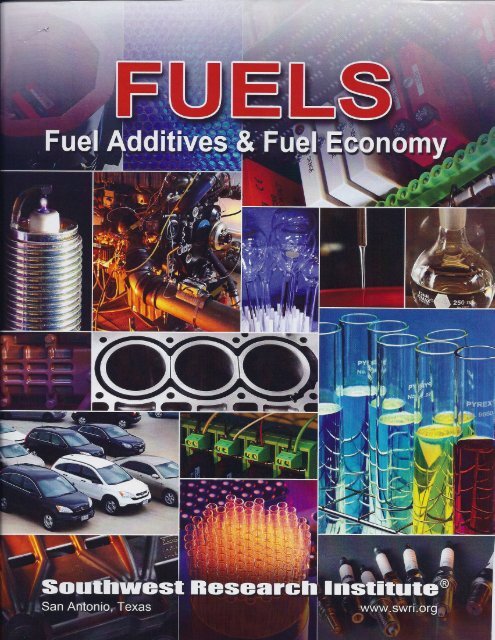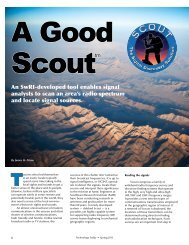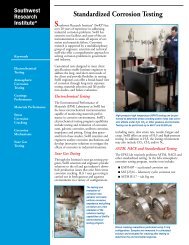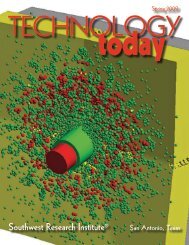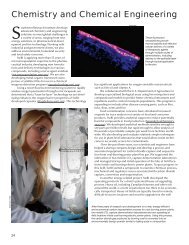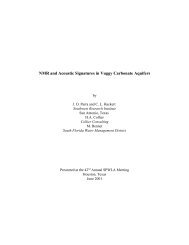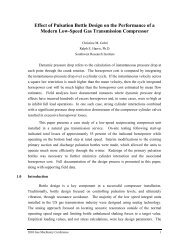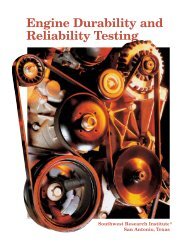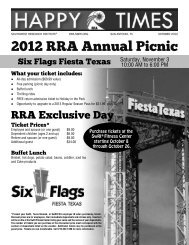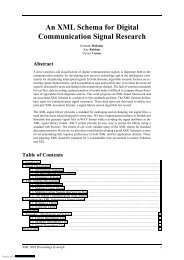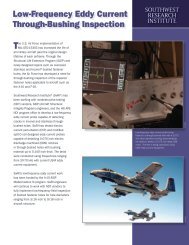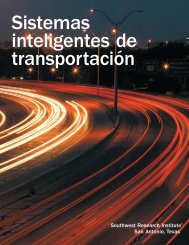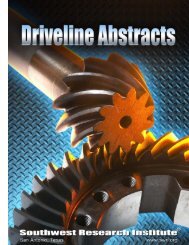Fuel Additives & Fuel Economy Abstracts - Southwest Research ...
Fuel Additives & Fuel Economy Abstracts - Southwest Research ...
Fuel Additives & Fuel Economy Abstracts - Southwest Research ...
You also want an ePaper? Increase the reach of your titles
YUMPU automatically turns print PDFs into web optimized ePapers that Google loves.
QUALITY CERTIFICATIONSThe <strong>Fuel</strong>s and Lubricants <strong>Research</strong> Division is:• Certified to ISO 9001: 2000, "Quality Management Systems - Requirements"• Accredited to ISO/IEC 17025: 2005, "General Requirements for theCompetence of Testing and Calibration Laboratories"• Certified to ISO 14001: 2004, "Environmental Management Systems"The Division has also achieved Ford Tier 1 status for providing engineeringservices, and has received the Ford Q1 Quality Award.In conjunction with these Divisional quality system accomplishments:• The Petroleum Products <strong>Research</strong> Department is a Nuclear ProcurementIssues Committee (NUPIC)-Approved Laboratory• The Engine and Lubricants <strong>Research</strong> Department has maintained its status asan American Chemistry Council (ACC)-Approved LaboratoryivSOUTHWEST RESEARCH INSTITUTESan Antonio, TexasJuly 2010
TABLE OF CONTENTSAftertreatment <strong>Research</strong> and Development ........................................................................... 1Catalyst Development, Application, and Aging ....................................................................................... 1Diesel Emissions ...................................................................................................................... 2Diesel <strong>Fuel</strong> Qualification ................................................................................................................................ 2Emissions <strong>Research</strong> and Development ................................................................................ 4Emissions Evaluation Using Engine Dynamometer .............................................................................. 3Fleet and Field Evaluations ..................................................................................................... 4Intake Valve Sticking Test (Vanagon) ........................................................................................................ 4Intake Valve Sticking Test (GM 5.0L V-8) ................................................................................................ 5Truck <strong>Fuel</strong> <strong>Economy</strong> Improvements .......................................................................................................... 6<strong>Fuel</strong> Performance Evaluations ................................................................................................ 7ASTM D 5500 BMW Intake Valve Deposit Test Procedure ................................................................ 7ASTM D 5598 Port <strong>Fuel</strong> Injector Deposit Test Procedure ................................................................... 8ASTM D 6201 Ford 2.3L Intake Valve Deposit Test Procedure ........................................................ 9Combustion Chamber Deposit Evaluations ........................................................................................... 10SCPI <strong>Fuel</strong> Injector Poppet Sticking Test ................................................................................................. 11Vehicle Driveability Testing ......................................................................................................................... 12Vehicle Octane Requirement Determinations andOctane Requirement Increase (ORI) Evaluations ......................................................................... 13<strong>Fuel</strong>s Analysis ........................................................................................................................ 14ASTM D6421 Port <strong>Fuel</strong> Injector Test (Formerly CRC Port <strong>Fuel</strong> Injector Test) ........................... 14High Frequency Reciprocating Rig (HFRR) ........................................................................................... 15Induction System Deposit <strong>Fuel</strong> Evaluation ............................................................................................. 16Scuffing Load Test As A Measure of Lubricity ...................................................................................... 17Intake Valve Deposit Apparatus ................................................................................................................ 18Light- and Heavy-Duty Vehicle Emissions and <strong>Fuel</strong> <strong>Economy</strong> .......................................... 19Emissions Light- and Heavy-Duty Evaluation Using Chassis Dynamometer .............................. 19vSOUTHWEST RESEARCH INSTITUTESan Antonio, TexasJuly 2010
Diesel EmissionsTopic:Diesel <strong>Fuel</strong> QualificationPoint of Contact:Test Objective:Bob FanickPhone: (210) 522-2653Fax: (210) 522-3950The objective of this test is to qualify one fuel bycomparing resulting emissions against another acceptedfuel.Apparatus:The apparatus used is principally a DDC Series 60 HDDiesel engine. Other post-1990 engines can besubstituted.Test Procedure:Repetitive EPA hot start transient emission tests areperformed.<strong>Fuel</strong> Requirement:The fuel requirement for this test is 250 gallons of eachtest fuel.Duration:The duration of this test is from 7 to 10 days, with 20 hotstarttransient tests on each fuel.Test Results: Test results include quantification of HC, CO, NO x ,particulate, SOF, and SO4.A PASS/FAIL determination is made with regard to NO x ,particulate, and SOF as compared to reference fuel.Note:This procedure is recognized by CARB.2SOUTHWEST RESEARCH INSTITUTESan Antonio, TexasJuly 2010
Emissions <strong>Research</strong> and DevelopmentTopic:Point of Contact:Test Objective:Emissions EvaluationUsing EngineDynamometerVlad UlmetPhone: (210) 522-2Fax: (210) 522-3950Objectives for this test include:• EPA transient, modal tests• Emissions mapping• Certification, audit, compliance• <strong>Fuel</strong>/additives effects• Control technology developmentApparatus:Various test apparatus may be used, with a power rangeof 1 hp to 2,500 hp or more.Test Procedure:<strong>Fuel</strong> Requirement:Duration:Test Results:Any transient or steady state schedule may be followed.This includes U.S., European, Japanese, and othercertification tests.Gasoline, diesel fuel, liquefied petroleum gas, natural gas,alcohols, biofuels, and blends in varying quantities may becalled for in this test procedure.The duration of this test procedure depends on the testobjective. Typical duration for these emissions tests isfrom 20 minutes to 1 hour.Test results vary according to procedure/objective.Usually, regulated emissions, particulate matter, and fuelconsumption are reported. Sometimes smoke orunregulated emissions may be reported. Numerousoptions are available depending on specific client needs.Note:3SOUTHWEST RESEARCH INSTITUTESan Antonio, TexasJuly 2010
Fleet and Field EvaluationsTopic:Point of Contact:Test Objective:Vehicle:Test Procedure:<strong>Fuel</strong> Requirement:Duration:Test Results:Intake Valve StickingTest (Vanagon)Larry EckhardtPhone: (210) 522-2980Fax: (210) 684-7523The objective of this test is to test fuel performance in theprevention of intake valve sticking at low temperature.The vehicle used in this test is a 1991 VolkswagenVanagon vehicle with 2.1-L four-cylinder engine and fourspeedtransmission.1. This 13-cycle dynamometer test consists of 6 minutesat 1,500 rpm, 5 minutes at 1,700 rpm, followed with a10-minute hot soak for each cycle.2. This is followed by 16 hours of cold soak at 0°F.3. Cylinder pressures are measured during three coldcranks at cold temperature.4. Steps 1-3 are repeated during the next two days.The fuel requirement for this test is 25 gallons.Duration is 2 weeks.(PASS/FAIL) A fuel passes the test if the crankingcompression of each cylinder is over 100 psi following thethree-day evaluation.Note:4SOUTHWEST RESEARCH INSTITUTESan Antonio, TexasJuly 2010
Topic:Point of Contact:Test Objective:Vehicle:Test Procedure:<strong>Fuel</strong> Requirement:Duration:Test Results:Intake Valve StickingTest (GM 5.0L V-8)Larry EckhardtPhone: (210) 522-2980Fax: (210) 684-7523The objective of this test is to test fuel performance in theprevention of intake valve sticking at low temperature.The vehicle used in this test is a 1990-1995 GMC-1500pickup truck with a 5.0-liter eight-cylinder engine withautomatic transmission.1. The 60-minute driving cycle consists of 56 minutes at55 mph and a 3-minute idle period. The remainingone minute is required to accelerate and deceleratethe engine and drivetrain during the driving period.The driving cycle is repeated three more times duringeach day for an approximate total mileageaccumulation of 200 miles.2. The driving cycle is followed by 16 hours of cold soakat –4 degrees F.3. Cylinder pressures are measured during three coldcranks at cold temperature.4. Steps 1-3 are repeated during the next two days.The fuel requirement for this test is 50 gallons.Duration is 2 weeks.(PASS/FAIL) A pass shall result in no stuck valves duringany of the three cold starts. A stuck valve is defined asone in which the cylinder pressure is less than 80% of thenormal average cylinder compression pressure.Note:5SOUTHWEST RESEARCH INSTITUTESan Antonio, TexasJuly 2010
Topic:Truck <strong>Fuel</strong> <strong>Economy</strong>ImprovementsPoint of Contact:Test Objective:Larry EckhardtPhone: (210) 522-2980Fax: (210) 684-7523The objective of this test is to evaluate fuel economybenefits associated with various fuel additives, oil additivecomponent, or devicesVehicle:Class-8 trucks and busses are used for this test.Test Procedure:Test procedures used include:SAE and TMC Joint Test Procedure (J1321 <strong>Fuel</strong>Consumption Test Procedure - Type II) and modifiedJ1321 for EPA Smartway®<strong>Fuel</strong> Requirement:The amount of diesel fuel required for this test depends onthe test plan used.Duration:The duration of the test is 6 to 8 weeks.Test Results: <strong>Fuel</strong> consumption is recorded (procedure accuracy ±1percent).Note:6SOUTHWEST RESEARCH INSTITUTESan Antonio, TexasJuly 2010
<strong>Fuel</strong> Performance EvaluationsTest:Point of Contact:Test Objective:Vehicle:Test Procedure:<strong>Fuel</strong> Requirement:Duration:Test Results:Note:ASTM D5500 BMW IntakeValve Deposit TestProcedureKevin BrunnerPhone: (210) 522-3579Fax: (210) 684-7523The objective of this test is to evaluate fuels’ ability tocontrol deposits on intake valves.For this test, a 1985 BMW 318i, four-cylinder, four-stroke,1.8-L vehicle with an automatic transmission is used.1. The vehicle is run 10,000 test miles with daily mileageaccumulation of 800 miles.2. A fixed route is run, consisting of:• 10 percent city• 20 percent secondary road• 70 percent highway3. Intake valves are weighed.The fuel requirement for this test is 500 gallons of fuel.The duration of this test is 4 weeks.The test is a PASS if the average intake valve depositweight is less than 100 milligrams per the four valves forEPA requirement and less than 50 milligrams per valve forCARB requirement. CARB also requires a combustionchamber deposit (CCD) weight determination and limitsthe level to 1,300 mg average or 140% as compared to abase fuel result.This test is run as a CARB procedure and as an EPAprocedure following ASTM Method D-5500.7SOUTHWEST RESEARCH INSTITUTESan Antonio, TexasJuly 2010
Topic:Point of Contact:Test Objective:Vehicle:Test Procedure:<strong>Fuel</strong> Requirement:Duration:ASTM D5598 Port <strong>Fuel</strong>Injector Deposit TestProcedureKevin BrunnerPhone: (210) 522-3579Fax: (210) 684-7523The objective of this test is to evaluate the tendency of agasoline to keep the port fuel injectors clean.A 1985-87 Chrysler 2.2-L turbocharged engine with anautomatic transmission is used for this test.The procedure for this test is as follows:1. PFI driving cycle:• 55 mph for 15 minutes• Engine-off soak for 45 minutes2. Flow test every 1,000 miles for 10,000 milesThe fuel requirement for this test is 500 gallons.The duration of this test is 8 weeks.Test Results: The test is a PASS if the fouling of all injectors remains 5percent or less for the entire 10,000-mile test.Note:A modified version of this test is available to evaluate thetendency of a gasoline to clean fouled port fuel injectors. Theprocedure for this test is as follows:1. For dirty-up phase, run 15/45 cycle, and flow test until atleast one injector is fouled to greater than 10 percent.2. For clean-up phase, run 15/45 cycle, and flow test every1,000 miles until fuel injector fouling is 5 percent or less.Clean-up is a PASS when the fouling of all four injectorsbecomes 5 percent or less.8SOUTHWEST RESEARCH INSTITUTESan Antonio, TexasJuly 2010
Topic: ASTM D6201 Ford 2.3LIntake Valve Deposit TestProcedurePoint of Contact:Kevin BrunnerPhone: (210) 522-3579Fax: (210) 684-7523Test Objective:Apparatus:Test Procedure:The objective of this test is to determine intake valvedeposit-forming tendency of unleaded gasoline, and/orgasoline additives.For this test, a 1994 Ford 2.3-L dual spark plug engine ona dynamometer test stand is used.1. The test cycle consists of:• 2,000 rpm and 230 mm Hg manifold absolutepressure for 4 minutes• 30-second ramp to 2,800 rpm• 2,800 rpm and 540 mm Hg manifold absolutepressure for 8 minutes• 30 second ramp to 2000 rpm2. The cycle is repeated for 100 hours.<strong>Fuel</strong> Requirement: The fuel requirement for this test is approximately 330gallons.Duration:Test Results:The duration of this test is 100 hours.This test is required to meet the TOP TIER DETERGENTGASOLINE DEPOSIT CONTROL PERFORMANCESTANDARD. A test is a PASS if the average intake valvedeposit (IVD) weight is less than 50 mg per the four valvesif the base fuel used had demonstrated a 500 mg averageIVD result. Also required for this standard is that thecombustion chamber deposit (CCD) weight be no greaterthan 140% as compared to a base fuel result.9SOUTHWEST RESEARCH INSTITUTESan Antonio, TexasJuly 2010
Topic:Point of Contact:Test Objective:Vehicle:Test Procedure:<strong>Fuel</strong> Requirement:Combustion ChamberDeposit (CCD)EvaluationsKevin BrunnerPhone: (210) 522-3579Fax: (210) 684-7523The objective of this test is to evaluate the capability of atest fuel or fuel additive to prevent CCD growth or to cleanCCDs previously formed.Various vehicles may be used for this test procedure.For CCD Thickness Measurements:Use a Fisher Permascope® thickness measurementdevice linked to a computer for data storage.For CCD Weight Measurements:Deposits are manually scraped into specially designedenvelopes. Deposits are then weighed to the nearest 0.1mg.Various amounts of fuel may be used for this procedure.Duration: This test procedure usually requires 10,000 to 20,000miles for deposit stabilization. The driving route shouldinclude a mix of city, suburban, and highway driving with asoak period.Test Results:Note:CCD thickness and weight measurements for the pistontop and combustion chamber regions of each cylinder aredetermined.CCD evaluations are usually incorporated into a fleetprogram that also includes intake valve deposit (IVD) andoctane requirement increase (ORI) evaluations.10SOUTHWEST RESEARCH INSTITUTESan Antonio, TexasJuly 2010
Test:Point of ContactTest ObjectiveApparatusTest Procedure<strong>Fuel</strong> RequirementSCPI <strong>Fuel</strong> InjectorPoppet Sticking TestKevin BrunnerPhone: (210) 522-3579Fax: (210) 684-7523The objective of this test is to evaluate the ability ofgasoline deposit control additives to prevent fuel injectorpoppet nozzles to stick closed. This test is part of the TOPTIER DETERGENT GASOLINE DEPOSIT CONTROLPERFORMANCE STANDARD.1998 to 2001 General Motors light-duty van equipped witha 4.3-L V6 engine and a Sequential Central Port Injection(SCPI) fuel injection system1. Flush vehicle fuel system with test fuel and install newinjectors.2. An automatic control system starts and idles the vehiclefor five minutes.3. The engine is then shut off and allowed to hot-soak for25 minutes.4. This cycle is repeated for a total of 192 cycles (96hours).5. The engine is allowed to hot-soak for 48 hours, duringwhich time the engine is not started but is maintained atoperating temperature.6. At the end of the 48-hour hot soak, the block heatersare turned off and the engine is allowed to coolnaturally to room temperature.7. An injector balance test is conducted to determinewhether any poppet nozzles are stuck closed.The fuel requirement for this test is 20 US gallons.11SOUTHWEST RESEARCH INSTITUTESan Antonio, TexasJuly 2010
Topic:Vehicle Driveability TestingPoint of Contact:Test Objective:Kevin BrunnerPhone: (210) 522-3579Fax: (210) 684-7523The objective of this test is to evaluate the effects of fuelor fuel additive on vehicle operation as related to depositformation or fuel volatility/driveability index.Vehicle:Various vehicles may be used for this procedure.Test Procedure:This test procedure may include:1. CRC cold start and warm-up driveability procedure2. BMW driveability procedure3. SAE procedure<strong>Fuel</strong> Requirement:The fuel requirement is dependent upon test objective andprocedure (10 gallons per evaluation).Duration:Duration of this test is dependent upon test objective andprocedure (24 hours per evaluation).Test Results:Total of weighted demerits is recorded at the end of thetest.12SOUTHWEST RESEARCH INSTITUTESan Antonio, TexasJuly 2010
<strong>Fuel</strong>s AnalysisTopic:Point of Contact:Test Objective:ASTM D6421 Port <strong>Fuel</strong>Injector Test (Formerly CRCPort <strong>Fuel</strong> Injector Test)Robert LeggPhone: (210) 522-2071Fax: (210) 522-4544The objective of this test is to evaluate fouling tendenciesof gasolines and the effects of additives by simulating theport fuel injector vehicle test.Apparatus:For this test, a port fuel injector bench rig is used.Test Procedure:1. The test cycle consists of:• 15 seconds of spray• 50 minutes of hot soak at 160°C• 10 minutes cool down2. Repeat for 44 test cycles.<strong>Fuel</strong> Requirement:The fuel requirement for this test is 2 gallons of fuel.Duration:The test duration is 44 hours.Test Results:Flow volume change is noted.Note:14SOUTHWEST RESEARCH INSTITUTESan Antonio, TexasJuly 2010
Topic:High FrequencyReciprocating Rig (HFRR)Point of Contact:Test Objective:Robert LeggPhone: (210) 522-2071Fax: (210) 522-4544The objective of this test is to define the wear resistanceof diesel fuels.Apparatus:The apparatus used for this test is a high-frequencyreciprocation rig (HFRR).Test Procedure:A 75-minute test is performed during which a ball slides ona flat specimen with a reciprocating motion. The diameterof the scar on the ball at conclusion of the test is noted asa measure of wear resistance.<strong>Fuel</strong> Requirement:The fuel requirement for this test is 10 ml diesel fuel.Duration:Test duration of this test is 75 minutes.Test Results:The wear scar diameter is recorded in millimeters.Note:This test procedure has been standardized asASTM D 6079.15SOUTHWEST RESEARCH INSTITUTESan Antonio, TexasJuly 2010
Topic:Point of Contact:Test Objective:Induction System Deposit<strong>Fuel</strong> EvaluationRobert LeggPhone: (210) 522-2071Fax: (210) 522-4544The objective of this test is to evaluate the tendency ofmotor gasolines to form induction system deposits bysimulating carburetor spark-ignition engine conditions.Apparatus:Test Procedure:<strong>Fuel</strong> Requirement:Duration:Test Results:An induction system deposit bench rig is used for this test.The test procedure is as follows:1. A 100-ml volume of the test fuel is sprayed onto thedeposit tube – 50 minutes2. Heat soak and cooling time – 10 minutes3. If required, repeat with additional 100-ml volume oftest fuelThe fuel requirement for this test is 100 to 300 ml of fuel.The duration of this test is 1 to 3 hours.The test results are measured by the deposit weight gainon the deposit tube for every 100 ml of fuel.Note: This test is described in Federal Test Method 500.1.16SOUTHWEST RESEARCH INSTITUTESan Antonio, TexasJuly 2010
Topic:Point of Contact:Test Objective:Scuffing Load Test As AMeasure of LubricityRobert LeggPhone: (210) 522-3367Fax: (210) 522-4544The objective of this test is to define the lubricity of dieselfuels under highly loaded conditions.Apparatus:A modified ball-on-cylinder lubricity evaluator (BOCLE) isused for this test.Test Procedure:The test procedure is as follows:• Laboratory scale wear test using ball-on-cylindergeometry.• Minimum applied load required for the on set of severeadhesive wear is taken as a measure of lubricatingquality.<strong>Fuel</strong> Requirement:For this test, 50 ml of diesel fuel is required.Duration:Duration of this test is 2 hours.Test Results:Test results recorded are load in grams to producescuffing.Note: This procedure has been standardized as ASTM D 6078.17SOUTHWEST RESEARCH INSTITUTESan Antonio, TexasJuly 2010
Topic:Point of Contact:Test Objective:Apparatus:Intake Valve DepositApparatusRobert LeggPhone: (210) 522-2071Fax: (210) 522-4544The objective of this test is to evaluate the foulingtendencies of a gasoline or the effectiveness of anadditive in preventing intake valve deposits.A bench rig to simulate the formation of intake valvedeposits is used for this test.Test Procedure: 1. Test cycle consists of :• 0.8 second spray every 10 seconds• Continuously heated valve2. The cycle is repeated for 20 hours.<strong>Fuel</strong> Requirement:Duration:Test Results:The fuel requirement for this test is 2 liters of fuel.The test duration is 20 hours.The valve weight increase is determined at the end of thistest.Note:18SOUTHWEST RESEARCH INSTITUTESan Antonio, TexasJuly 2010
Light- and Heavy-Duty Vehicle Emissionsand <strong>Fuel</strong> <strong>Economy</strong>Topic:Point of Contact:Test Objective:Vehicle:Test Procedure:<strong>Fuel</strong> Requirement:Emissions Light- andHeavy-Duty EvaluationUsing ChassisDynamometerKevin WhitneyPhone: (210) 522-5869Fax: (210) 522-3950The objectives of this test are:• Control technology development• <strong>Fuel</strong>/additives effects on emissions and fuel economy• Emission characterization• Emissions certificationAny light-duty vehicle, or heavy-duty vehicles such asurban buses or semi-tractor may be selected for use.Transient operation over any schedule, most steady-stateconditions, at controlled temperatures (10°F to 120°F) areavailable for light-duty work.<strong>Fuel</strong> requirements for this test are as required by client.Gasoline, diesel fuel, ethanol blends, liquefied petroleumgas, natural gas, and biofuel blends in varying quantitiesmay be called for in this procedure.Duration: Cycles and modes typically range from 20 minutes to 1hour. Most tests require preparation and 12-hour soak.Test Results:Test results from this test typically include:• Regulated & unregulated emissions• Vehicle & tested component performance data• Modal analysis and continuous raw emissions• <strong>Fuel</strong> consumptionNote:19SOUTHWEST RESEARCH INSTITUTESan Antonio, TexasJuly 2010
Notes:________________________________________________________________________________________________________________________________________________________________________________________________________________________________________________________________________________________________________________________________________________________________________________________________________________________________________________________________________________________________________________________________________________________________________________________________________________________________________________________________________________________________________________________________________________________________________________________________________________________________________________________________________________________________________________________________________________________________________________________________________________________________________________20SOUTHWEST RESEARCH INSTITUTESan Antonio, TexasJuly 2010


